What immune cell features are most predictive of COVID outcomes?
@mkuchroo @JcsHuang Patrick Wong et al used ML algorithm Multiscale PHATE to assign each immune cell type in COVID patients a mortality-likelihood score. Latest from @KrishnaswamyLab 💪🏼 (1/)
go.nature.com/3K0QCqi
@mkuchroo @JcsHuang Patrick Wong et al used ML algorithm Multiscale PHATE to assign each immune cell type in COVID patients a mortality-likelihood score. Latest from @KrishnaswamyLab 💪🏼 (1/)
go.nature.com/3K0QCqi

Based on the flow cytometry data on 54 million cells from COVID 168 patients, the low density granulocytes (neutrophils and eosinophils) were the most enriched cell types in patients who had fatal COVID, followed by inflammatory monocytes and certain B cell subsets. (2/) 

In contrast, T cells (most of them; see below), NK cells and dendritic cells were associated with the lowest mortality likelihood scores. They are likely protecting the host from lethal disease. (3/)
When you dive into each of the lymphocyte subsets though, things start to look very interesting. Among the CD4 T subsets, while Th1, IL-4+, IL-6+ cells are protective, IL-17* cells that also produce IFN-g & granzyme B (red) have the highest mortality likelihood score. (4/) 

Within the CD8 T cell subsets, hyperactivated CD8+ T cell (CD8+CD45RA+TIM3+HLA-DR+PD1+) TEMRA cells expressing granzyme B were correlated with lethality, while naive cells had the lowest mortality likelihood score. (5/) 

The beneficial vs. pathogenic roles of T cells in COVID have been noted before. However, the Multiscale PHATE assigned vastly different mortality scores to each T cell subset with distinct effector functions. Seeing this from @mkuchroo was definitely a wow moment for me. (6/)
What about B cells? Plasmablasts (brown) had highest mortality likelihood score. In contrast, a subset of late-activated mature B cells defined by CD86+ (green) was most enriched in patients with good outcomes. Consistent with a previous study. pubmed.ncbi.nlm.nih.gov/32910469/ (7/) 



We are so fortunate to work with Dr. @KrishnaswamyLab and her team on this project. Her team keeps innovating new techniques to analyze complex and massive data with method that can learn and visualize cellular features - something immunologists love to do ❤️ (8/)
But they are just getting started 💪🏼 @KrishnaswamyLab also found a way to generate hard to obtain data from easy to obtain ones. For example, they can use ‘feature mapping GAN’ to model patients' flow cytometry data from clinical monitoring data 🤯 (9/)
cell.com/patterns/fullt…
cell.com/patterns/fullt…
This collaboration highlights the power of interdisciplinary research. When immunologists work together with computer scientists, amazing insights can emerge (there’s a lot more in this paper). Highlighting all the authors who contributed to the study 👇🏽 (end) 

• • •
Missing some Tweet in this thread? You can try to
force a refresh












